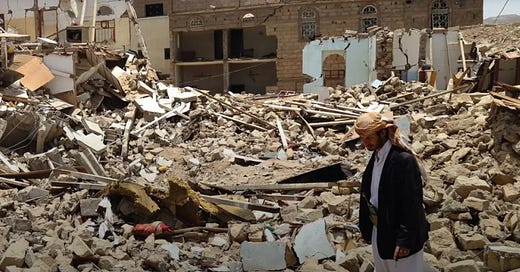What Grows from the Barrel of a Gun? Trump’s 100 Days of War
In the first 100 days of the Trump Administration, the United States has not only returned to the theatre of war; it has rebuilt the stage. Under the renewed leadership of President Donald Trump, American military presence across the globe has escalated with an urgency and scale that demands scrutiny, not celebration. From the Red Sea to the Rio Grande, the empire has awakened: louder, bolder, and more indifferent to consequence.
At the heart of this surge is Operation Rough Rider, an aggressive campaign launched in mid-March against Houthi-controlled regions of Yemen. More than 800 airstrikes have been carried out. B-2 bombers have flown black across the night sky; drones, silent and unblinking, have delivered “precision” payloads. The stated goal? To dismantle missile and drone launch sites threatening commercial shipping in the Red Sea and Gulf of Aden.
But underneath the antiseptic language of military briefings lies something much more troubling: the normalization of overwhelming, unaccountable force. This is not peacekeeping. It is power projection. It is spectacle. It is an old empire performing a new act.
On April 28, that performance crossed a line. A U.S. airstrike hit a detention center in Saada, Yemen, killing at least 68 people, mostly African migrants. The Pentagon has not confirmed details. It hasn’t had to. The public relations machine does not pause for civilian casualties, and the news cycle moves on quickly. But for those who perished, there is no next headline. Only silence, rubble and death.
This silence has become the soundtrack of American foreign policy. Humanitarian groups warn of violations of international law. Civilian deaths mount. Meanwhile, the administration justifies its actions with abstract words like "security" and "sovereignty," draining them of meaning with every detonation.
This is not a policy unique to Yemen. Under the banner of NATO solidarity the United States has increased troop deployments across Europe, as tensions with Russia continue to simmer. In Asia, joint military exercises with allies have become more frequent and more forceful, aiming to contain China’s regional ambitions. We are witnessing the reassertion of American military primacy; not just in one region, but globally.
And it does not stop at foreign borders.
At home, thousands of troops have been sent to the U.S.–Mexico border in the name of immigration control. Uniformed soldiers patrol scrublands, surveil migrant routes, and reinforce border checkpoints, bringing the machinery of war into the domestic sphere. The line between national defense and internal enforcement blurs. The militarization of immigration policy signals a dangerous turn inward, a vision of the homeland not as refuge, but as fortress.
The strategy is clear. Military solutions are being prioritized over diplomatic ones. Strength is being measured in sorties, not in treaties. The Trump administration has made force its default posture, not its last resort.
But what does this posture produce? Critics argue that a reliance on military might over diplomacy breeds instability. That it hardens resistance. That it creates more enemies than it neutralizes. That it risks dragging the U.S. into protracted, unwinnable conflicts. And that it does so with staggering human cost.
What grows from the barrel of a gun? Not peace. Not prosperity. Not justice. What grows there is fear. Resentment. Grief. What grows there are unmarked graves in distant deserts, and silence where there should be accountability.
In his first 100 days, President Trump has reasserted American dominance through force. But history has shown us again and again that power without foresight leads not to greatness, but to ruin. We must ask not just where these wars are taking us, but what they are making of us.
Because someday soon, the cost will come due: not in dollars, but in lives. And long after the last drone returns to base, the consequences of this recklessness will remain.




